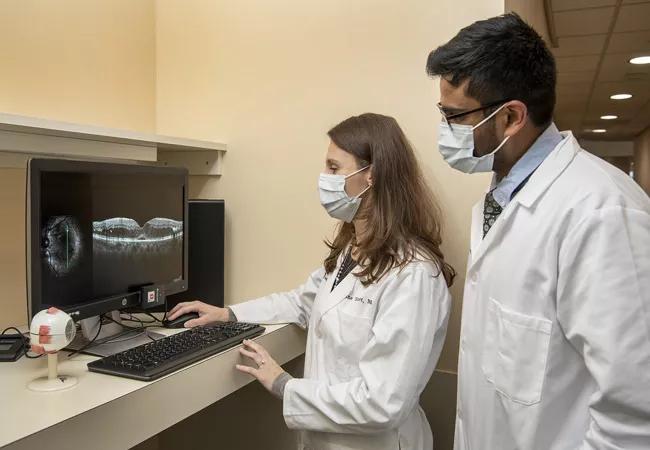Former internship year now includes specialization in eye care

Pictured above: Katherine Talcott, MD, Associate Residency Program Director at Cole Eye Institute, helps train PGY2 resident Joseph Abraham, MD.
Advertisement
Cleveland Clinic is a non-profit academic medical center. Advertising on our site helps support our mission. We do not endorse non-Cleveland Clinic products or services. Policy
Is three years enough time to train future ophthalmologists? Traditionally, residency programs have managed with three years of ophthalmic education following trainees’ one year of general internship. But due to changes announced in 2019 by the Accreditation Council for Graduate Medical Education (ACGME), eye programs have begun integrating internship with residency training, essentially turning ophthalmology residencies into four-year programs.
Cole Eye Institute will begin its four-year residency program in July 2022. The planning, including administrative and scheduling changes, is already underway.
“We have a great opportunity to revamp ophthalmology training,” says vitreoretinal surgeon Katherine Talcott, MD, who was recently named Associate Residency Program Director at Cole Eye Institute. “We need to determine the best way to use this extra time with residents to enhance their education.”
Dr. Talcott, who spent a year as Chief Resident at Massachusetts Eye and Ear before joining Cleveland Clinic in 2018, will work with Residency Program Director Jeffrey Goshe, MD, to determine the design of the new internship year (PGY1).
“In the past, ophthalmology programs had no control over internship training,” says Dr. Talcott. “Now we will. At Cole Eye Institute, our PGY1 residents still will be exposed to a mix of inpatient and outpatient services, but they’ll also have three months of ophthalmology training. This earlier exposure to eye care will help increase their clinical exam skills and build a solid foundation for the three years of training to come.”
Advertisement
Over the other nine months of general medical training, PGY1 residents will be introduced to rheumatology, neurology, dermatology, infectious disease and other medical fields that often intersect with ophthalmology when caring for patients with eye conditions.
“We want to build trainees’ knowledge about those conditions,” says Dr. Talcott. “This new PGY1 experience also will help our ophthalmology faculty forge new clinical partnerships in those other fields.”
In addition to expanding the residency program from three years to four, Cole Eye Institute will increase the number of residents per year from four to five.
“Our department has greatly expanded over the past decade, so it makes sense to expand our residency cohorts accordingly,” says Dr. Goshe. “There are so many educational opportunities here, including many faculty members interested in teaching. We want to capitalize on that.”
Additional residents will require additional educators, which will mean additional rotation options — still to be determined.
The newly integrated internship and residency program will offer trainees more continuity in their ophthalmic education, notes Dr. Talcott. Because trainees will be at Cleveland Clinic all four years, they can take advantage of educational opportunities sooner, including Grand Rounds and the numerous didactic conferences regularly held at Cole Eye Institute.
“They’ll have an extra year to start research projects and form relationships with mentors as well,” says Dr. Talcott. “More time at Cole Eye Institute will only improve their training experience.”
Advertisement
Advertisement
Advertisement

Motion-tracking Brillouin microscopy pinpoints corneal weakness in the anterior stroma

Registry data highlight visual gains in patients with legal blindness

Prescribing eye drops is complicated by unknown risk of fetotoxicity and lack of clinical evidence

A look at emerging technology shaping retina surgery

A primer on MIGS methods and devices

7 keys to success for comprehensive ophthalmologists

Study is first to show reduction in autoimmune disease with the common diabetes and obesity drugs

Treatment options range from tetracycline injections to fat repositioning and cheek lift